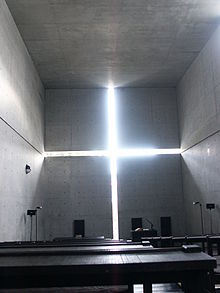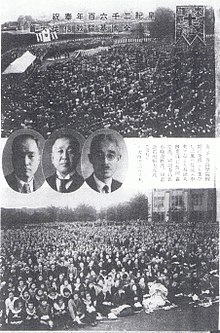United Church of Christ in Japan
The United Church of Christ in Japan (日本 キ リ ス ト 教 団Nihon Kirisuto Kyōdan , English: United Church of Christ in Japan , abbreviations: Kyodan , UCCJ ) is the largest Protestant church in Japan . It has approximately 196,000 members in 1,725 parishes.
history
Protestant Christianity came to Japan from 1858 through the work of American missionaries. These belonged to churches of the Presbyterian Reformed spectrum. As a result of the mission, the first Protestant church in Japan, Nihon Kirisuto Kyokai , was established in Yokohama in 1872 . At its synod in 1890 this church formulated its own creed. In the understanding of today's United Church of Christ in Japan, this church was non-denominational.
Missionaries from other Protestant churches came to Japan a little later, so that a number of denominational churches emerged. At the same time, the Japanese Evangelical Christians were looking for ways of ecumenical cooperation.
With the Law on Religious Communities, the Japanese government proposed the unification of all Protestant-type churches. On October 17, 1940, a large gathering of Christian lay people from all over Japan took place in Tokyo to celebrate the 2,600th anniversary of the Japanese Empire and to express the wish for church unity. Then on June 24 and 25, 1941, delegates from over thirty churches in Fujimichio came together to found the Nihon Kirisuto Kyodan . (This church was founded in the self-understanding of the United Church of Christ in Japan through the work of the Holy Spirit and on the basis of divine providence.) The representatives of the church then went to the great shrines of Ise to attend the main Shinto shrine Amaterasu (the sun deity) to communicate the church union. The representatives of the Nihon Kirisuto Kyodan stated that their members were Japanese citizens, that overcoming denominational boundaries was an expression of their loyalty to Japan and that they wanted to support the emperor .
After Japan's defeat in World War II, the Law on Religious Organizations was annulled and religious freedom was restored. On October 16, 1946, the Nihon Kirisuto Kyodan affirmed that it would continue to exist as the Unification Church.
However, since the United Church of Christ in Japan had come into being as a state ordained union church, some integrated churches withdrew from it: the Anglicans, the Lutherans, some Baptist congregations and congregations of the sanctification movement, as well as the Salvation Army . In 1951 the United Church of Christ lost another 39 congregations that wanted to continue the tradition of Nihon Kirisuto Kyokai and their creed of 1890.
The larger incorporated churches that chose to remain in the United Church of Christ in Japan (mainly Congregationalists, Methodists, and Presbyterian Reformed) had different reasons for doing so. The church constitution was presbyterial-synodal, but the church government had little opportunity to influence the local churches; So Kyodan was de facto a congregational church in which the individual local churches had a lot of freedom to shape their parish life. The Methodists had had a bad experience with the episcopate and were not interested in reintroducing it. In the Presbyterian Reformed congregations before the church union of 1941, internal disputes over questions of faith and church order had taken place, in the resurgence of which there was no interest.
On October 26, 1954, Kyodan formulated its own creed.
In 1967, the Executive Committee of the United Church of Christ in Japan acknowledged responsibility for the Japanese war crimes in World War II . The Japanese government intervened in the organization of religious communities for political reasons so that they could cooperate in the war effort. The founding of one's own church is classified within this framework.
The church is critical of the remilitarization of Japan and the use of nuclear power.
Church constitution
- The United Church of Christ in Japan professes the Christian faith, which is founded in the scriptures of the Old and New Testaments and conforms to the early church and evangelical creeds ( conformed to the Ecumenical Creeds and to the evangelical Confessions of Faith ).
- The leadership of the church is done by the general assembly, the implementation of the decisions of the general assembly according to the constitution of the church is the task of the moderator .
- A local church of the United Church of Christ is chaired by the local church congregational meeting , moderated by the pastor of the church. Local congregations hold services on Sundays at the times they set, and the sacraments are also administered. "A church service consists of songs, scripture reading, sermons, prayers, collections, etc."
- The Church ordains pastors after they have received appropriate training. In addition to the ordained ministers in full standing, there are licensed preachers who have been commissioned by the church to preach the word.
Christian lifestyle
The church members enter into the following pledge :
- To live according to the order of the Church, to cherish Sunday worship, to partake of the sacrament , to share the gospel and to devote time, resources and talents to it;
- reading the Bible daily , being steadfast in prayer, and generally living a pious, pure, moderate, hardworking life;
- To serve God through family devotions and a harmonious family life in which children grow up in faith;
- to strive for righteousness and love, as taught by Jesus Christ , to spread throughout the world: through appreciation of the personality of every fellow human being, charity and commitment to the welfare of the community;
- to uplift the morality of the taste according to God's will and to achieve justice and peace worldwide.
theology
The theological training of prospective pastors takes place at the church's own private university, the Tokyo Union Theological Seminary (東京 神学 大学Tōkyō shingaku daigaku ). Facilities for theological training had existed since the beginning of the American mission. The amalgamation of these seminars developed parallel to the merger of the churches, so that with the state-ordained church union of 1941, the entire evangelical theological training was brought together in one place, the Tokyo Union Theological Seminary, founded in 1943. The language of instruction is Japanese.
Kazoh Kitamori (北 森 嘉 蔵Kitamori Kazō ), professor of dogmatics at this seminar from 1949 until his retirement in 1984, has also been received in German-speaking countries with his main work "The Theology of God's Pain".
Many theologians of the United Church of Christ in Japan received their doctorates in Germany.
Memberships
The United Church of Christ in Japan has been a member of the World Council of Churches since 1948 . She is a member of the Japanese National Christian Council and the Christian Conference of Asia.
Web links
- Own web presence: The United Church of Christ in Japan
- Tokyo Union Theological Seminary
Individual evidence
- ↑ a b c United Church of Christ in Japan. In: ems. Retrieved November 17, 2018 .
- ↑ a b c d United Church of Christ in Japan. In: World Council of Churches. Retrieved November 17, 2018 .
- ↑ a b c d e f A Brief History of the Kyodan. In: UCCJ. Retrieved November 17, 2018 .
- ^ A b c Atsuyoshi Fujiwara: Theology of Culture in a Japanese Context: A Believers' Church Perspective . In: Princeton Theological Monograph Series . tape 179 , 2012, p. 236 .
- ↑ a b c d e The Constitution. In: UCCJ. Retrieved November 17, 2018 .
- ↑ James M. Phillips: From the Rising of the Sun: Christians and Society in Contemporary Japan . Orbis Books, 1981, pp. 181 .
- ^ Confession of the responsibility during World War II. In: UCCJ. Retrieved November 17, 2018 .
- ^ Guidelines for Christian Living. In: UCCJ. Retrieved November 17, 2018 .
- ^ Historical Sketch. In: TUTS. Retrieved November 17, 2018 .

